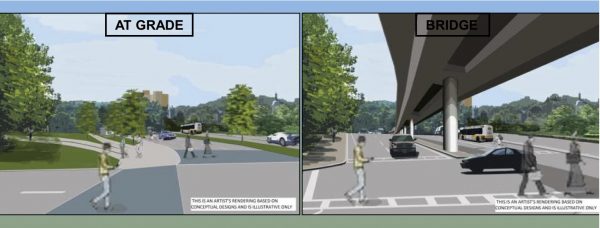Tear Down Casey Overpass
For almost a year, MassDOT has been holding meetings to discuss replacing the on-going disaster that is Casey Overpass in Jamaica Plain. Constructed in the 1950s, the bridge was meant to connect drivers heading east and west by running Route 203 up and over Washington Street and Hyde Park Avenue in the Forest Hills neighborhood. The rationale: Drivers wouldn’t need to wait at a traffic light.
Today, Casey Overpass is in shambles, down to just one lane in each direction and covered with potholes — it’s impossible to go much faster than 30 miles per hour over the bridge without completely destroying your shocks. (Trust me: I live less than a mile away). MassDOT has already committed to taking it down, and has been trying to decide — along with community members, elected officials, and neighborhoods groups — how to replace it. Late last year, MassDOT unveiled the two options:
Option 1: New Bridge
Cost: $73 million.
Traffic solution: 2 lanes in each direction on the bridge, and 2 lanes in each direction on the ground
Amenities: None.
Capable of handling traffic: Yes.
Option 2: Surface Option
Cost: $52 million.
Traffic solution: 3 lanes on the ground in each direction
Amenities: Protected bike lanes on Washington Street, increase size of Southwest Corridor Park, and MBTA improvements at Forest Hills station.
Capable of handling traffic: Yes.
Now, when I look at those two options, one screams: I AM THE RIGHT CHOICE. If we go with a surface option, we’re going to save $21 million, get more park space, and add protected bike lanes. Not to mention reconnecting Frederick Olmsted’s Emerald Necklace between the Arnold Arboretum and Franklin Park? And we could finally rejoin the Forest Hills neighborhood with the rest of Jamaica Plain, like we did with the North End to great effect? Yes, please.
But instead of MassDOT being able to move forward, bridge supporters, led by state Rep. Liz Malia, have been holding up the process. As she told the Jamaica Plain Gazette last week (Malia did not respond to my request for an interview): “My concern is that there [should] be a broad enough study of how traffic really flows and who’s using Forest Hills so that we don’t create more of a problem than what we’ve got today.”
Very well, then: Traffic studies show that around 24,000 cars currently use the bridge daily (remember: it’s only one lane in each direction), while another 12,000 use a parellel street on the ground. A grand total of 36,000 cars, which makes it a busy street, but by no mean Boston’s busiest — Melnea Cass Boulevard handles about the same. MassDOT’s traffic analysis show that the at-surface option can handle the traffic easily — the only effect would be a one-minute delay for drivers at rush hour. Yup: One minute, and only for people at rush hour.
Malia and the bridge supporters didn’t believe those studies, so they commissioned their own independent traffic analysis. That report, done by a third-party engineer, found that MassDOT’s analysis was right. (The independent report did level criticism at the Highway Capacity Manual, but that’s unlikely to change any time soon, seeing that every single road in America follows those standards.) Instead of moving on, though, bridge supporters are honing their talking points and surfing the internet for “iconic under-bridge spaces,” to try to convince people that the bridge will be nice! You won’t be scared to walk under it like Boston’s other bridges!
No, the problem is that Rep. Malia and the bridge supporters have a myopic focus on cars. They forget the fact that bicyclists might actually want to use the road too, that pedestrians would rather cross a street to the park than walk under a bridge, and that we have the chance to finally knit back together the fabric of a reawakening neighborhood. Because certainly, none of those things would be worth inconveniencing our rush hour drivers, even if it’s just for a minute.





